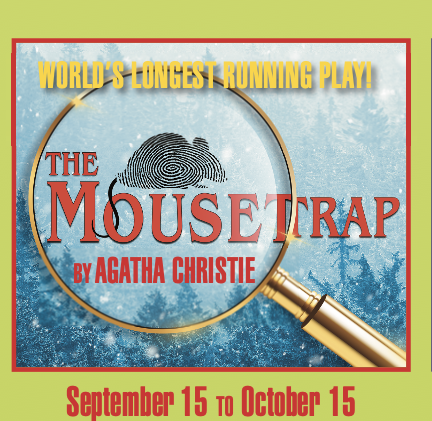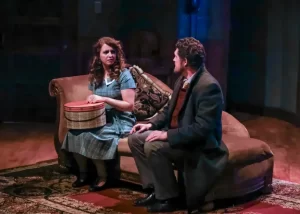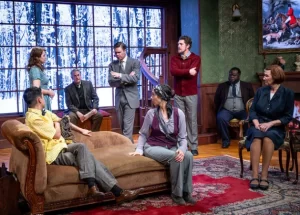
 **** In her autobiography, Agatha Christie recounts a conversation with theater impresario and the producer of “The Mousetrap” shortly after the show’s premier. “Fourteen months, I’m going to give it,” said Saunders. To which Christie replied “It won’t run that long. Eight months perhaps. Yes, I think eight months perhaps.” Of course, we now know that “The Mousetrap” is the longest continuously running stage production in London and has been staged countless times by amateur and professional theater groups around the world.
**** In her autobiography, Agatha Christie recounts a conversation with theater impresario and the producer of “The Mousetrap” shortly after the show’s premier. “Fourteen months, I’m going to give it,” said Saunders. To which Christie replied “It won’t run that long. Eight months perhaps. Yes, I think eight months perhaps.” Of course, we now know that “The Mousetrap” is the longest continuously running stage production in London and has been staged countless times by amateur and professional theater groups around the world.
The plot of this famous whodunnit involves seven strangers snowed in at a remote countryside guesthouse as reports of a recent murder in London come over the radio. A police sergeant shows up to investigate the London murder, and his interrogation techniques pit each of the characters (who harbor a secret or two) against each other.
In Citadel Theatre’s production (running now through October 15th) the 1952 setting of the play gets some added “oomph” by Cinematographer Ian Merritt’s use of Pangaea Technology (special video screens) which made their first appearance at Citadel during their production of “The Christians.” Merritt, along with Director Scott Westerman and Scenic Designer Catalina Nino, have taken the video technology to a new level, completely integrating the Pangaea panels into multiple portions of the set. Audience members will immediately notice the raging blizzard viewed through the large window of the living room of “Monkshead Manor,” as well as a fire blazing in the fireplace and two paintings and a mirror on the wall, all utilizing Panagea panels. Two notable advances over previous uses of the video panels are first, seeing a video version of a character outside and then have them enter the set live and second, having a character look at themselves in the mirror and having a video version of themselves reflected back. Other special effects appear during the course of the show, but, like the twist ending, I am leaving those for the audience to discover for themselves. Production Managers Ellen and Scott Phelps have been prescient in bringing this phenomenal technology to a suburban location.
Brian Elston (Lighting Designer) and Peter Wahlback (Sound Designer) do a phenomenal job of creating a tense, mysterious atmosphere. Wahlback’s variations on the play’s “theme song” of “Three Blind Mice” are particularly creepy. Costume Designer Danielle Reinhardt for the most part does an excellent job of recreating the early 1950’s look for each character, as well as allowing the costumes to convey clues about their personalities. (For instance, Kristie Berger who plays retired judge Mrs. Boyle, enters wearing a magnificent fur coat.) However, some of the characters are dressed in short sleeves, which seems to be out of place for the middle of winter in England.
Any actor would “kill” for any of the of the eight roles in this tightly woven, fast paced play. This cast is top-notch and engages the audience in understanding the humanity underneath the characters’ various crotchets. Ms. Berger is the snooty Mrs. Boyle, who is dissatisfied with everything and everyone. Jesus Barajas pays Chrsitopher Wren, a young, flamboyant gay man who enjoys pranking the other inn residents. Reginald Hemphill is Mr. Paravinci, a foreigner whose car breaks down near the inn in the middle of the blizzard. His background is vague, and he appears heavily made up.to look older than he really is. William Ryder plays Major Metcalf, a retired army officer. On the night I attended, Ryder’s English accent faded in and out a bit during the course of the show, but his character was solid. Amy Stricker is Miss Caswell, a vaguely mannish young woman who appears to enjoy flaunting convention. Mary Margaret McCormack and Jack Sharkey play Molly and Giles Ralston respectively, a young, naïve couple who have converted the old Monkshead Manor estate into an inn and have had the misfortune to open it on the night of this terrible blizzard. Rounding out the cast is Sean Erik Wesslund as Detective Sergeant Trotter. He is the epitome of the classic British detective—stiff upper lip, always in control and not a wrinkle in his grey suit.
The show runs approximately two hours with one fifteen-minute intermission. Due to some violent scenes, it may not be appropriate for some younger children.
Performances are Thursdays, Fridays and Saturdays at 7:30 p.m. and Sunday matinees at 3 pm. There will be a Saturday matinee on October 7 at 2 p.m. and a Wednesday matinee at 1 p.m. on September 27. There will be no performances on Fridays, September 22 and 29. Prices for regular run on Wednesdays, Thursdays and Fridays are $40 and for Saturdays and Sundays $45. Discounts are available for groups, seniors and students. Tickets are available online at www.citadeltheatre.org or by calling the box office at 847-735-8554 extension 1.
Citadel Theatre is located in the West Campus Building of the Lake Forest School District, 300 South Waukegan Road, Lake Forest IL
To see what others are saying, visit www.theatreinchicago.com, go to Review Round-Up and click at “The Mousetrap”.





More Stories
“Jaja’s African Hair Braiding”
“Chicago , the Musical” Reviewed by Amy Menzel ( MILWAUKEE)
“shucked”